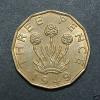|
|
The current range of books. Click the image above to see them on Amazon (printed and Kindle format). More info on coinpublications.com |
|
|

Heard a really strange tale today and I'm wondering what the scientific explanation is...
By
1949threepence, in Free for all
 Coinpublications.com
Coinpublications.com